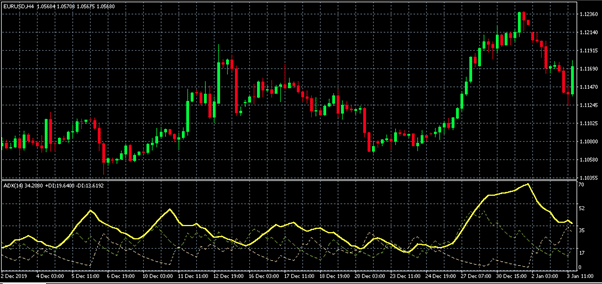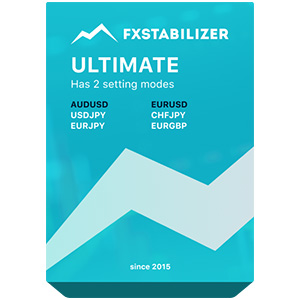
交易者使用數十種技術分析工具來在外匯市場取得成功。有些人獨立評估情況,研究價格圖表和額外的指標。其他人需要幫助來應對大量的技術信息,並連接提供現成解決方案或獨立交易的最佳外匯機器人。
無論如何,指標都是至關重要的。它們幫助確定趨勢方向及其強度。雖然大多數新手專注於買入和賣出信號,但經驗豐富的交易者則試圖了解新興趨勢的強度和持久性。平均趨向指標(ADX)可以幫助他們。接下來,我們將討論如何在您的策略中使用平均趨向運動指數以及如何計算它。
理解平均趨向指數(ADX)

什麼是平均趨向指數?這是由著名金融分析師韋爾斯·怀尔德(Welles Wilder)在1970年代開發的一個有用的技術工具。該指標不受市場方向影響,顯示趨勢的穩定性。它的值範圍從0到100。數值越高,趨勢越強。在解釋時,您應該檢查價格是上漲還是下跌,因為ADX在平盤時無法可靠工作。
我們應該從如何在圖表上顯示ADX外匯指標教程的信息開始。該指數通常由三條線組成,可以在MT4、MT5和其他平台上啟用。在ADX本身旁邊,還顯示了負向指標(-DI)和正向指標(+DI)。使用這些附加曲線,您可以了解趨勢的強度和方向。儘管該指數的計算相當復雜,但在實際交易中使用起來很容易。
平均趋向指数计算
在Excel中计算平均趋向运动指数很方便,因为计算需要使用来自多个周期(通常为14个)的数据。以下是一个逐步计划和最终的平均趋向指数公式。这些信息是为了熟悉和更好地理解ADX的工作原理而提供的。在实践中,交易程序会自动进行计算并绘制图表。因此,以下是逐步算法:
1. 计算计算期间(Wilder建议采用14个间隔)的+DM(趋向运动)和-DM,使用以下公式:
+ DM = 当前蜡烛高点 - 前一个蜡烛高点
- DM = 前一个蜡烛低点 - 当前蜡烛低点
最大值将用于进一步计算。
2. 使用以下公式计算真实间隔:
TR = 当前蜡烛高点 - 当前蜡烛低点
TR = 当前蜡烛高点 - 前一个蜡烛收盘价
TR = 当前蜡烛低点 - 前一个蜡烛收盘价
在计算中使用最大值。
3. 计算14个周期内+DM、-DM和TP的平均值。
4. 使用以下公式计算+DI和-DI:
+DI = ((平滑+DM)/ATR)*100
-DI = ((平滑-DM)/ATR)*100
其中ATR是平均真实范围。
使用以下公式找到方向指数(DI):
DI = ((+DI - -DI)/(+DI + -DI))*100
5. 使用以下公式计算14个周期的平均趋向指数指标:
ADX = ((先前ADX * 13) + 当前ADX)/14
由於這些複雜的操作,您將獲得一條曲線,它將相當準確地顯示當前趨勢的強度。在交易策略中使用ADX
儘管其視覺顯示非常簡單,ADX指標包含了大量信息。因此,主線可用於確定趨勢的強度,而輔助線則用於可能的逆轉。所有這些數據都可以成功地納入您的平均趨向指數策略中,並與其他方法一起使用。 趨勢的強度顯示了開啟或關閉交易的最佳時機。它展示了銷售量與購買量的比例,並提供了對市場參與者信心的一般理解。當賣家和買家之間大致平衡時,我們在圖表上看到一個平穩,ADX曲線趨於零。反之,如果平衡向多頭或空頭傾斜,ADX圖表將上升。 要在您的交易策略中使用ADX平均趨向指數,您應正確解釋其值。以下是大致範圍及其含義:- 不到20%。支撐和阻力水平之間的範圍較低。價格幾乎不變。此時,最好觀望並等待額外的確認。
- 從20%到30%。在這個階段開倉還為時過早,但有強勁趨勢的趨勢。在這裡檢查+DI和-DI是有意義的,以獲取有關方向的信息。
- 從30%到40%。趨勢的確定確認。這是開倉的有利時刻。
- 從40%到50%。這個值的平均趨向指數含義最清晰。趨勢在這裡具有最大的動力。
- 超過50%。在這個範圍內,趨勢可能會消退並改變方向。在這裡重要的是分析其他指標並等待逆轉信號。
ADX指標外匯有時會給出虛假信號,尤其是在小時段上,但總體上非常準確。同時,考慮+DI和-DI給出的趨勢方向信號也很有用:
- +DI從下向上穿越-DI並繼續向上移動。這是一個看漲的趨勢信號。
- +DI從上向下穿越-DI並繼續向下移動。這是一個看跌的趨勢信號。兩條曲線的最大偏離表示強勁的趨勢。價格反轉在這裡非常可能發生。
在工作中使用這些數據,您將獲得一個額外的工具,幫助您做出更加平衡和準確的決策。
ADX使用的限制
如果您知道如何在外匯中計算平均趨向指數,這仍然不足以進行正確的實施。要獲利使用它,您需要了解所有可能的限制。這些限制可能涉及ADX線和DI線。
+DI和-DI接近或相交的情況表示市場大致平衡。市場可能會長時間保持這種狀態,因此,頻繁的交叉可能會誤導。重要的是等待更大的偏離,這樣它才能成為您決策的基礎。
指標值也是如此。如果平均趨向運動指數外匯上升超過20%甚至接近30%,這還不是開倉的100%信號。曲線同樣可以迅速下降並返回到平穩區。您可以使用其他指標來測試您的假設,以免過早進入市場。
ADX在外匯交易中的應用:實用提示
要學習如何使用平均趨向指數並充分利用它,您可以使用以下專家提示:
- 在價格圖表平穩時,不要注意ADX。在這段時間內,該指標可能會給出虛假信號。
- 趨勢的開始在20%到30%的區域。當ADX達到這個範圍的末端時進入市場。
- 對於不同的貨幣對,範圍可能略有不同,因此重要的是要進行自己的觀察。
- 不要使用小於H1的時間框架。
遵循這些提示,並將ADX指標與其他工具結合使用,您將能夠進行更有效和有利可圖的交易。
結論
ADX外匯指數結合了兩個關鍵功能。它顯示了趨勢的強度,其附加線提供了有關可能反轉的信息。該指標具有相當復雜的公式,但在所有交易平台上都可以自動計算。使用它時,您將能夠在正確的時間進入交易並退出市場。當然,您應該記住可能的虛假信號,並且只能在與其他工具結合使用時使用ADX外匯交易策略。









